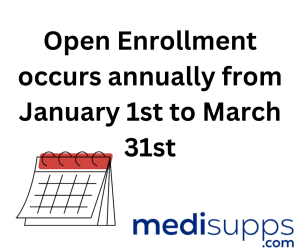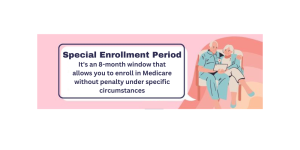
by Russell Noga | Updated December 15th, 2023
White-knuckling the uncertainty of healthcare costs can be distressing. However, thanks to Medicare Supplement Insurance, also known as “Medigap,” you can rest a little easier knowing there’s a safety net to catch those unforeseen medical expenses.
But how can you ensure you’re getting the best possible coverage, especially during the critical Medicare open enrollment supplemental insurance period? The answer lies in understanding the intricacies of Medigap insurance, and that’s exactly what we’re here to discuss.
Key Takeaways
- During open enrollment, Medicare Supplement Insurance can be obtained without facing higher premiums or denial of coverage.
- The Initial Enrollment Period is the ideal time to purchase a Medigap policy. Comparison of plans and provider networks is essential for choosing the most suitable plan.
- Guaranteed Issue Rights provide protection from denial of coverage outside initial enrollment period, while Special Enrollment Periods are available for those who meet certain criteria.
Understanding Medicare Supplement Insurance and Open Enrollment
Medicare Supplement (Medigap) plans are designed to complement Original Medicare by filling in the coverage gaps and assisting with out-of-pocket expenses not covered by Medicare Parts A and B. These gaps could include copayments, coinsurances, and deductibles, which can quickly add up if you require frequent or extensive medical care.
Open enrollment is a pivotal time in the Medicare program. This period, which usually begins when an individual turns 65 and enrolls in Medicare Part B, allows you to enroll in Medicare Supplement Insurance without penalties, undergoing medical underwriting, or facing denial of coverage.
It is the most advantageous time to secure a Medigap plan because insurance companies, during this period, cannot refuse coverage or impose higher premiums due to pre-existing conditions.
Discover 2024 Plans & Rates
Enter Zip Code
The Critical Timeline: Navigating Your Medigap Open Enrollment Period

The Medigap Open Enrollment Period is a significant six-month interval starting when an individual turns 65 and enrolls in Medicare Part B. This period offers an excellent opportunity to procure a Medigap policy without the requirement for medical underwriting, ensuring you won’t be penalized or denied coverage based on your health condition.
However, this enrollment window won’t stay open forever. If you miss the open enrollment period, you might find yourself navigating rough waters.
You could be subject to increased costs or even coverage denial, particularly if you have pre-existing health conditions.
The six-month period ends on the final day of the month, six months after you turn 65 and enroll in Medicare Part B – this is your deadline for selecting a Medigap plan.
First Steps in the Initial Enrollment Period
The most opportune time to purchase a Medigap policy is during the initial enrollment period. This period, which commences when you turn 65 or older and enroll in Medicare Part B, offers the best opportunity to acquire a Medicare Supplement policy without any penalties or medical underwriting.
However, once this six-month window closes, the availability and cost of acquiring a Medigap policy may become restricted, potentially affecting your coverage and expenses.
Understanding Guaranteed Issue Rights
Guaranteed Issue Rights are safeguards that protect beneficiaries from being denied coverage or facing elevated costs due to their health status in specific circumstances, such as when they are purchasing Medigap policies beyond their open enrollment period.
An example of this is when individuals disenroll from Medicare Advantage within 12 months of their initial enrollment. These individuals have the right to purchase a Medigap policy, regardless of their medical history.
However, beneficiaries applying for Medigap coverage after their initial six months of enrollment in Medicare Part B could risk policy denial or higher premiums, particularly if they have pre-existing conditions.
Eligibility and Enrollment: Who Can Purchase Supplemental Insurance?
Before you can even think of buying a Medigap policy, you must first be enrolled in both Medicare Part A and Part B, collectively known as Original Medicare.
However, if you’re enrolled in a Medicare Advantage plan, you’re ineligible to purchase a Medigap policy. It’s like trying to mix oil and water; they simply don’t mix.
State regulations also play a significant role in Medigap coverage, particularly when it comes to pre-existing conditions. Each state has specific rules regarding the coverage of these conditions under Medigap, which significantly influence the policy application process.
Hence, it’s advisable to acquaint yourself with your state’s regulations before applying for a Medigap policy.
Comparing Plans: How to Choose the Right Medigap Coverage

Selecting the appropriate Medigap plan is akin to finding the ideal pair of shoes; it needs to be a perfect fit for your individual needs. With ten diverse Medigap plans available, denoted by letters A, B, C, D, F, G, K, L, M, and N, each offering different coverage options and benefits, finding the right fit may seem challenging.
However, by evaluating costs, benefits, and provider networks, the ideal plan can be identified, akin to selecting the perfect pair of shoes.
Analyzing Costs and Benefits
When comparing Medigap plans, it’s imperative to consider both the costs and benefits. The cost of Medigap plans can vary based on several factors, including age, location, and health needs.
Premiums can range from $50 to over $300 monthly, with less expensive plans potentially costing as little as $30-$40 per month for a 65-year-old. But don’t let the price tag fool you.
Like a glitzy pair of stilettos, a lower-price plan might seem attractive, but if it doesn’t provide the coverage you need, you could be left footing a costly bill.
The benefits of Medigap insurance policies typically include coverage for Medicare-covered services like hospital stays, doctor visits, and medical procedures. However, they usually do not cover prescription drugs, routine vision and dental care, hearing aids, eyeglasses, long-term care, and private-duty nursing.
Weighing the costs and benefits of each plan against your healthcare needs and budget is crucial to assure maximum value for your investment.
Provider Networks and Flexibility
Another crucial factor to consider when selecting a Medigap plan is the provider network. In the context of Medigap insurance, provider networks generally aren’t applicable.
Medigap plans can be used with any doctor or hospital that accepts Medicare. This means you have the freedom to select any healthcare provider who accepts Medicare, providing you with increased flexibility and access to a broader range of healthcare facilities.
However, not all Medigap plans provide the same level of flexibility in terms of provider networks. The extent of provider network flexibility can differ depending on the specific Medigap plan.
It’s like shopping for a new outfit; you wouldn’t buy a pair of pants without first checking if they fit. Likewise, when choosing a Medigap plan, it’s necessary to assess the details of each plan to understand the provider network options offered.
 Switching Plans: Making Changes During Medicare Open Enrollment
Switching Plans: Making Changes During Medicare Open Enrollment
The Medicare Open Enrollment period, which occurs annually from January 1st through March 31st, allows beneficiaries to switch plans.
However, your health condition could influence your available options and costs during the Medicare Supplement Open Enrollment.
For example, if you have existing health issues, you may confront higher premiums or even coverage denial.
The Impact of Health Status on Plan Choices
Your health status can significantly influence your Medigap plan choices. For instance, those with pre-existing health conditions may face restricted options or increased premiums when choosing a plan.
However, federal guarantees and protections are in place to ensure coverage regardless of pre-existing conditions, although a maximum wait period of six months can be applied for coverage of these conditions.
For individuals with disabilities, there might be some light at the end of the tunnel. Some states provide options for beneficiaries under 65 and with disabilities, ensuring they have access to supplemental coverage, as allowed by federal law.
So, if you fall into this category, make sure to explore your options.
Late Enrollment: Consequences and Alternatives

Enrolling late in Medigap could be like showing up late to a party; you might miss out on the best bits. Consequences may include the possibility of coverage denial, dependent on your age, health status, and location, and the potential for higher premium costs.
Indeed, there’s a 10% increase in the Part B premium for every successive 12-month period you were eligible for but did not enroll in Medigap coverage.
Avoiding the Late Enrollment Penalty
Avoiding the late enrollment penalty requires timely action during the Initial Enrollment Period or utilizing guaranteed issue rights.
These rights protect individuals from being refused coverage or facing higher charges due to health status or pre-existing conditions and enable them to enroll in Medicare or Medigap plans without penalties, even if it’s outside the initial enrollment period.
Additional Coverage Considerations: Drug Plans and Extended Care
Beyond standard Medigap coverage, other considerations such as Part D drug coverage and extended care options should be considered when choosing an insurance company.
Some key points to keep in mind about Part D prescription drug plan are:
- The average monthly premium for stand-alone Part D plans in 2023 is projected to be $40.
- These plans vary significantly in terms of the prescription drugs they cover.
- They may also have utilization management restrictions, like prior authorization, quantity limits, and step therapy.
Taking these factors into account will help you make an informed decision about your Medicare coverage.
The Inflation Reduction Act has made some significant impacts on Medicare Part D, including:
- Setting a limit on cost-sharing for insulin at $35 per month per prescription across all Medicare Part D plans
- Mandating that plans cannot impose higher charges for covered insulin products
- Not requiring all insulin products to be covered by plans
These changes aim to make insulin more affordable and accessible for Medicare beneficiaries.
 How to Enroll: Steps to Secure Your Medigap Policy
How to Enroll: Steps to Secure Your Medigap Policy
Now that we’ve navigated the labyrinth of Medigap coverage, it’s time to take the plunge and secure your policy.
But where do you start?
Here are the steps to follow:
- Be enrolled in both Medicare Part A and Part B.
- Compare the Medigap plans that are available in your area and suitable for your specific needs.
- Use the Medigap plan finder tool or get in touch with an insurance agent to obtain detailed information.
Once you’ve selected a plan, it’s time to apply. You can locate and complete a Medigap application form through the official CMS website or by requesting one from an insurance provider offering Medigap plans.
Remember to have your documentation ready, including:
- Proof of age
- Citizenship or legal residency
- Your social security card
- Current health insurance information.
Beyond Open Enrollment: Special Circumstances and Year-Round Options
Aside from the open enrollment period, there are also Special Enrollment Periods and continuous enrollment opportunities for those with unique circumstances or needs.
These enable beneficiaries to make adjustments to their coverage in response to specific events or circumstances. The specific regulations and timeframes for these special periods may differ, so verifying them based on your unique circumstances is advised.
Special Enrollment Periods and Their Qualifications
Special Enrollment Periods are predetermined times outside of the regular open enrollment window when you can modify your coverage due to particular life events. These life events include:
- reaching the age of 65
- experiencing loss of employer coverage
- relocating outside of your plan’s service area
- gaining or losing Medicaid eligibility
- meeting the criteria for the Extra Help program
Continuous Enrollment Opportunities
Continuous enrollment opportunities present another feasible option for maintaining your Medicare coverage.
As long as you meet the eligibility criteria and fulfill premium payments, you can sustain your Medicare coverage indefinitely, without a specified end date or time limit. So, even if you’ve missed the open enrollment window, you’re not entirely out of luck.
Maximizing Benefits: Utilizing Preventive Services and Care Coordination
You’ve got your Medigap coverage, now how can you make the most of it? The answer lies in utilizing preventive services and care coordination.
Preventive services covered by Medigap include:
- Examinations
- Vaccinations
- Lab tests
- Screenings
- Health monitoring programs
- Counseling
- Education
These services prioritize prevention over treatment, early detection of health issues, and addressing health concerns through screenings, check-ups, and counseling.
Care coordination is another way to maximize your Medigap benefits. It involves:
- The integration of medical and community resources to provide comprehensive and coordinated care
- Evaluating an individual’s needs across medical, physical, and social support
- Developing a personalized care plan
This ensures your healthcare services are integrated, harmonizes various care aspects, and reduces unnecessary hospitalizations, leading to more efficient utilization of Medigap benefits.
Compare Medicare Plans & Rates in Your Area
Summary
In this comprehensive guide, we navigated the intricate waters of Medigap insurance, from understanding what it is and how it complements Original Medicare, to the critical open enrollment period, eligibility criteria, comparing plans, and enrollment steps.
We’ve also highlighted the importance of preventive services and care coordination, special enrollment periods, and continuous enrollment opportunities.
With this knowledge, you’re now equipped to make informed decisions about your Medigap coverage and ensure you’re getting the best possible protection against unforeseen medical expenses.
Compare 2024 Plans & Rates
Enter Zip Code
Frequently Asked Questions
Does Medicare Supplement open enrollment take place?
Yes, Medicare Supplement open enrollment takes place in the six-month period that starts when you are both 65 or older and enrolled in Medicare Part B. During this period, you are guaranteed issue for any Medigap plan offered in your area.
Can you enroll in Medicare Supplement plans at any time?
You can enroll in Medicare Supplement insurance at any time as long as you are enrolled in Original Medicare Part A and Part B.
When a Medicare Supplement policy is purchased during the open enrollment period?
During the 6-month open enrollment period that begins when you turn 65 and are enrolled in Medicare Part B, you can purchase a Medicare Supplement policy at the best available rate regardless of your health status, with no risk of denial. This is the best time to buy a Medigap policy, as options and costs may become more limited afterwards.
What factors should I consider when comparing Medigap plans?
When comparing Medigap plans, it’s essential to take into account the cost and coverage benefits, as well as the network of providers and degree of flexibility.
What are Special Enrollment Periods and who qualifies for them?
Special Enrollment Periods are times outside the standard open enrollment window that allow individuals to make changes to their coverage due to life events such as reaching age 65, experiencing loss of employer coverage, or relocation. These periods are available to those who meet specific qualifications.
Find the Right Medicare Plan for You
Finding the right Medicare plan doesn’t have to be confusing. Whether it’s a Medigap plan, or you have questions about Medicare Advantage or Medicare Part D, we can help.
Call us today at 1-888-891-0229 and one of our knowledgeable, licensed insurance agents will be happy to assist you!

Russell Noga is the CEO and Medicare editor of Medisupps.com. His 15 years of experience in the Medicare insurance market includes being a licensed Medicare insurance broker in all 50 states. He is frequently featured as a featured as a keynote Medicare event speaker, has authored hundreds of Medicare content pages, and hosts the very popular Medisupps.com Medicare Youtube channel. His expertise includes Medicare, Medigap insurance, Medicare Advantage plans, and Medicare Part D.



